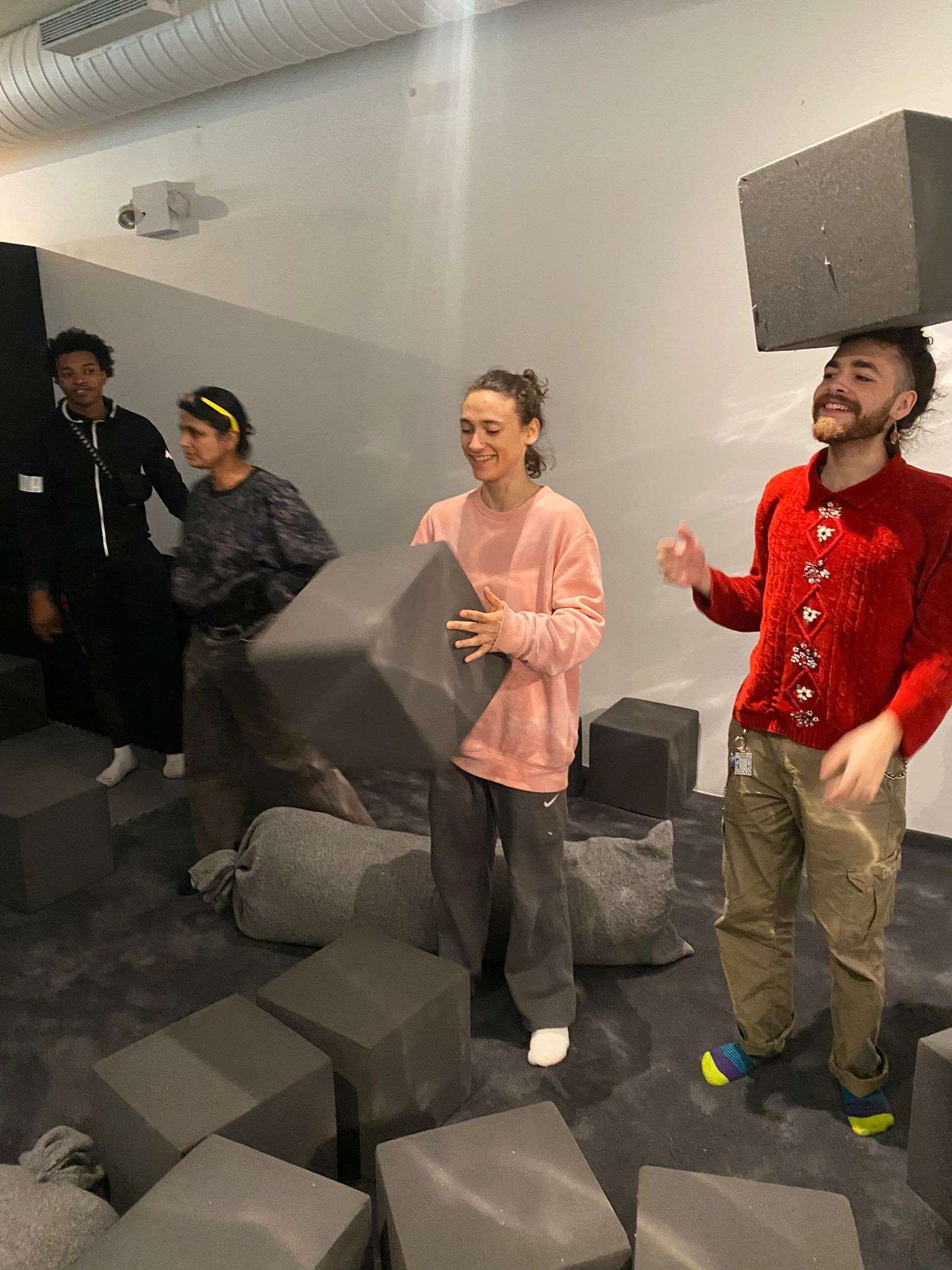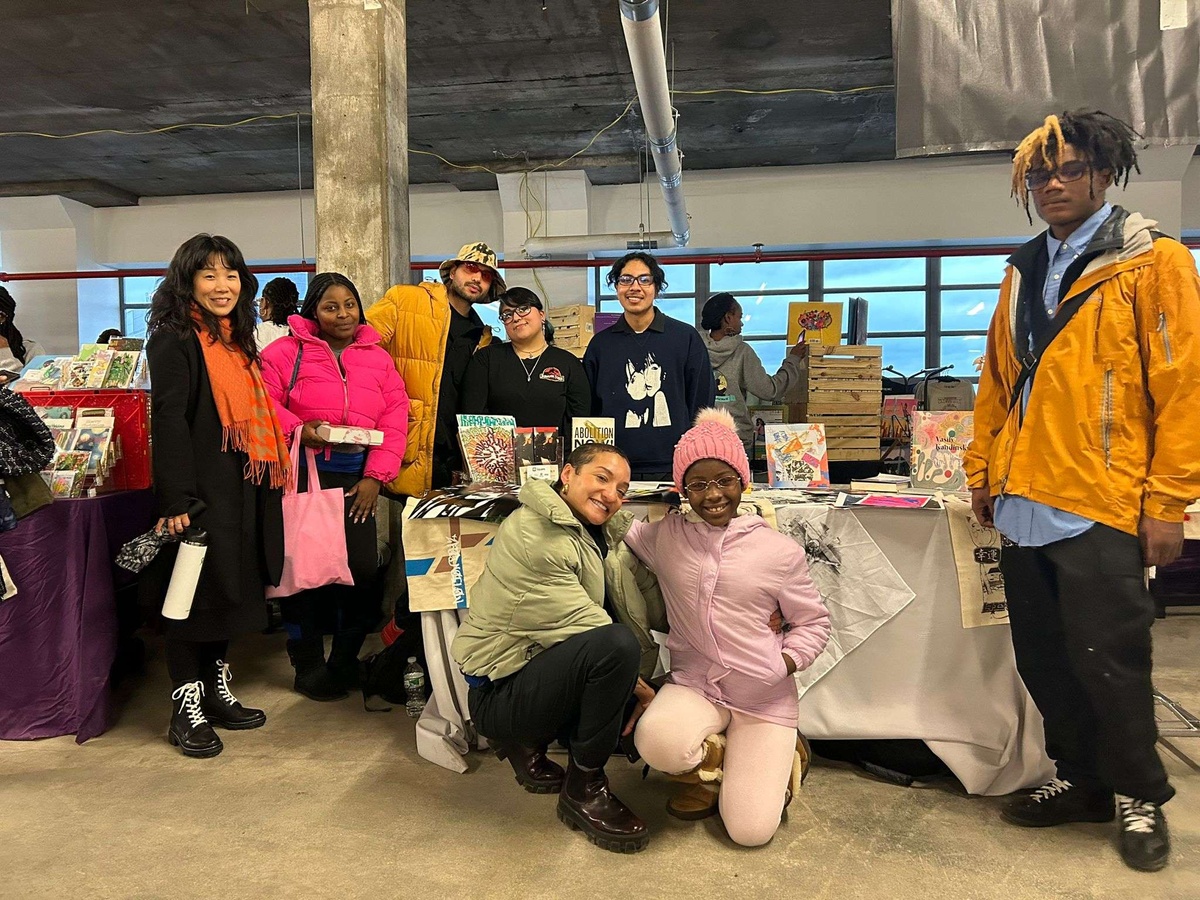Recess Reflections—Part 2 of 3
Artist & Organizer KT Kennedy and Artist & Social Worker Helen Park on care as resourcing.




Assembly Fellows and Peer Leaders take turns experiencing a sound installation by Session artists A. Sef and Akeema-Zane.
Assembly Fellows and Peer Leaders take turns experiencing a sound installation by Session artists A. Sef and Akeema-Zane.
KT Kennedy: Hi, my name is KT Kennedy and I am the Youth & Community Organizer at Recess.I am a multidisciplinary artist, art educator, and youth program coordinator based in Brooklyn, NY committed to resource sharing, artistic expression, and community engagement art as tools for liberation– And I'm with:
Helen Park: My name is Helen Park. I am the Artist Social Worker at Recess.
K.T. : What we're here to do is talk about us as Assembly practitioners and how we both define ‘resource’ and use it within our daily work as individuals and throughout the collective. Founded in 2016, Assembly offers system-impacted young folks ages 18-26 an inroad to art and connections to working artists, while serving as an alternative to incarceration. The curriculum empowers young people to take charge of their own life story and envision a future through art. The program diverts both misdemeanor and felony charges, and accepts community service and mental health mandates. We also expanded to include a peer-to-peer referral model, allowing us to broaden our reach and provide more avenues of youth autonomy.
My work as an organizer and researcher are intertwined. How we interact and engage with community as an organizer, with care, accountability, creativity, and intention is how I approach resourcing. Resourcing in Assembly looks intersectional, is accessible, and seen through a lens based in community safety. We define community safety not solely as the absence of violence, but also in the cultivation of joy. And therefore, for the individual and the collective, resourcing can look like many different things.
Needs span somatic practice, transportation support, emergency funds, mental health support, community engagement, and relationships among the collective–knowing that community keeps us safe and nourished. Our approach to resources might be abstract—we are creatives and we use art to find creative solutions as resources. We see the mission of Recess as a guidepost to resourcing in itself, moving with care and accountability.
The intention is to be responsive to the needs of our young folks with an awareness of their complex intersecting identities. We're working within complex systems. Systems of houseless-ness, food insecurities, etc. And we seek to resource our community members because that's what it takes for people to show up and have the capacity to create,to imagine, and tell our stories. As Assembly practitioners we support this work in many ways.
So, Helen, you have a unique role in resourcing. Can you share where you have located the urgencies for which the resources have been used?




Assembly Alumni at the Opening Reception of an exhibition in collaboration with NYU Gallatin.
H.P. : The position of Artist Social Worker in the organization actually came from a need to have mental health integration to support Assembly youth. I approach resourcing from a holistic perspective, which is in tandem with all of what you just shared, KT, about the intersections of need that we see in our young people. And so therefore, for me, resourcing has to also be approached from an intersectional lens; it has to be systemic and relational. I also define resources from the framework of somatic therapies, and mental, emotional and spiritual health. It’s not just material and physical support, but also your creative practice, it's your spiritual practice, it's connecting to nature and the earth and its emotional regulation practices. It's all of these things that can tend to someone's nervous system and well-being so that they can be able to show up fully, during their art making and also when showing up in the community.
In terms of the urgencies we've seen at Recess for young people in Assembly, it comes directly from these systems that can and do really impact someone's well-being. That can include food insecurity and houselessness, as you mentioned, any sort of direct involvement with carceral systems, trauma—early childhood trauma, relational and family trauma—all of these things can come together to compound an individual’s lived experience.
That can show up in Assembly unfortunately in times of crisis, when, for example, someone's facing imminent risk of losing housing, then facing insecurity around just being able to get basic needs met. So that's where we've seen a perfect storm of all of the various external factors, the causes and conditions coming together to put someone into a place of extreme precarity.
So our process now in response to those conditions is to address the immediate need in whatever ways we can with the emergency fund, which consists of monetary reserves allocated to a young person and also staff members when they are in an acute crisis. The other way we try to meet that need is where I come in to find referrals outside of Recess to support young people, because we want to address the short term crisis, and we also want to find more long term sustainable solutions for a young person. We're trying to be more preemptive, so that a young person doesn't actually reach a point of crisis. Most importantly, we're trying to work with them more intimately and collaboratively in terms of the mental health and the systemic social work aspects to be able to identify any risk factors ahead of time, before they get into crisis.
K.T. : Yes-thank you! Recess itself is this expansive creative ecosystem, and so, we resource with creativity and skill building. Nourishing the personal narrative is a part of how we define what resourcing is. Redefining notions of criminality–especially through storytelling and self-expression, is a central part of our work,providing new ways of telling our individual stories. Within all the pillars of Assembly: creative storytelling, somatic practice, and challenging narratives of criminality, are all versions of resourcing and how we approach complex systems of harm.
That is our job as organizers, artists AND resourcers. To make this work proactive and to implement community safety through joy, creativity, and community. We strive to grasp resourcing at the root,really understanding where we can intervene early, so we can limit harm, especially for our young folks. This effect then ripples out to our communities.


Helen and KT with Assembly Peer Leaders and Fellows selling artwork and goods at a 2022 Holiday Market.
H.P. : That's great. That really frames our intentionality of not being reactive. Because when we're not feeling resourced, we're in that survival, reactive mode. And so how do we as an organization support our young people to get ahead of any issues that might arise? I would also like to address the question of where our process of resourcing has reached limitations. How do we understand what those limits are? I think the monetary emergency funds can only do so much and address the immediate needs of a crisis. And that's important, but in taking a more holistic and sustainable approach, we also know that this requires so much more. So that could mean community referrals. It could be psychoeducational workshops in mental health topics. It's doing a lot of somatic practice and storytelling, which can be very similar actually to narrative therapy. And we're also teaching mind-body practices like meditation and yoga, really encouraging young people to understand how internal resources are always available and how to access that. All of those things are important, including our relationships with all of our young people and between each other. Even as staff, we're a part of the network of interdependent relationships along with our young people.
We define wellness not simply as the absence of illness, but the presence of thriving, creativity, and growth. And that's our part—to get our young people closer to that place. My approach is steeped in the belief that it is not only on the individual to create mental health and well-being for themselves. It is relational. Safety itself is a relational practice. Being resourced occurs through relationships, whether that's with other people or with nature, creation, and the land. We have to feel related and connected. And that's such a huge part of how we're approaching mental health at Recess–to help someone in their individual situation, but also to see their well-being as connected to relationships in the wider community. I think in order to really be able to face the many intersecting systems that impact our young people, like carceral systems, housing, food insecurities, etc., we must utilize the emergency funds in tandem with practices in collective care, as well as referrals to external community-based agencies that are setup to do the wraparound services. All of those are the necessary building blocks for support.
K.T. : Thank you!
H.P. : Thank you for having this conversation with me!